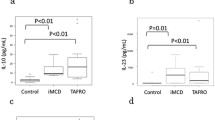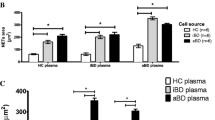Abstract
OX40, a member of the tumor necrosis factor receptor (TNFR) superfamily, co-stimulates activated T cells following interaction with its own ligand OX40L. Human T-cell leukemia virus type-1 (HTLV-1) is an etiological agent of adult T-cell leukemia (ATL). ATL cells are known to express cell surface OX40; however, the level of soluble OX40 (sOX40) in blood samples from ATL patients is unknown. Quantitative enzyme-linked immune-sorbent assay (ELISA) showed that sOX40 levels were significantly higher in plasma from acute ATL patients than those from asymptomatic HTLV-1 carriers and healthy donors, and correlated with sCD25 levels and HTLV-1 proviral loads in peripheral blood mononuclear cells (PBMCs). Fresh PBMCs from acute ATL patients showed a higher percentage of OX40-positive cells compared with those from carriers, and shed sOX40 into culture supernatants. Shedding of sOX40 was partially inhibited by a matrix metalloproteinase (MMP) inhibitor, GM6001. A fraction of sOX40 was capable of binding to OX40L. These results suggest that high levels of sOX40 are shed into blood from a large number of ATL cells in acute ATL patients. Thus, abnormally elevated plasma sOX40 levels may be useful as an additional diagnostic marker of acute ATL.






Similar content being viewed by others
References
Mallett S, Fossum S, Barclay AN. Characterization of the MRC OX40 antigen of activated CD4 positive T lymphocytes—a molecule related to nerve growth factor receptor. EMBO J. 1990;9(4):1063–8.
Ishii N, Takahashi T, Soroosh P, Sugamura K. OX40-OX40 ligand interaction in T-cell-mediated immunity and immunopathology. Adv Immunol. 2010;105:63–98.
Croft M. Control of immunity by the TNFR-related molecule OX40 (CD134). Annu Rev Immunol. 2010;28:57–78.
Tanaka Y, Inoi T, Tozawa H, Yamamoto N, Hinuma Y. A glycoprotein antigen detected with new monoclonal antibodies on the surface of human lymphocytes infected with human T-cell leukemia virus type-I (HTLV-I). Int J Cancer. 1985;36(5):549–55.
Hinuma Y, Nagata K, Hanaoka M, Nakai M, Matsumoto T, Kinoshita KI, et al. Adult T-cell leukemia: antigen in an ATL cell line and detection of antibodies to the antigen in human sera. Proc Natl Acad Sci USA. 1981;78(10):6476–80.
Ishitsuka K, Tamura K. Human T-cell leukaemia virus type I and adult T-cell leukaemia-lymphoma. Lancet Oncol. 2014;15(11):e517-26.
Miyoshi H, Ohshima K. Epidemiology of malignant lymphoma and recent progress in research on adult T-cell leukemia/lymphoma in Japan. Int J Hematol. 2018;107(4):420–7.
Ohshima Y, Tanaka Y, Tozawa H, Takahashi Y, Maliszewski C, Delespesse G. Expression and function of OX40 ligand on human dendritic cells. J Immunol. 1997;159(8):3838–48.
Takasawa N, Ishii N, Higashimura N, Murata K, Tanaka Y, Nakamura M, et al. Expression of gp34 (OX40 ligand) and OX40 on human T cell clones. Jpn J Cancer Res. 2001;92(4):377–82.
Pichler K, Kattan T, Gentzsch J, Kress AK, Taylor GP, Bangham CR, et al. Strong induction of 4-1BB, a growth and survival promoting costimulatory receptor, in HTLV-1-infected cultured and patients’ T cells by the viral Tax oncoprotein. Blood. 2008;111(9):4741–51.
Kress AK, Grassmann R, Fleckenstein B. Cell surface markers in HTLV-1 pathogenesis. Viruses. 2011;3(8):1439–59.
Imura A, Hori T, Imada K, Ishikawa T, Tanaka Y, Maeda M, et al. The human OX40/gp34 system directly mediates adhesion of activated T cells to vascular endothelial cells. J Exp Med. 1996;183(5):2185–95.
Imura A, Hori T, Imada K, Kawamata S, Tanaka Y, Imamura S, et al. OX40 expressed on fresh leukemic cells from adult T-cell leukemia patients mediates cell adhesion to vascular endothelial cells: implication for the possible involvement of OX40 in leukemic cell infiltration. Blood. 1997;89(8):2951–8.
Hintzen RQ, de Jong R, Hack CE, Chamuleau M, de Vries EF, ten Berge IJ, et al. A soluble form of the human T cell differentiation antigen CD27 is released after triggering of the TCR/CD3 complex. J Immunol. 1991;147(1):29–35.
Del Prete G, Maggi E, Pizzolo G, Romagnani S. CD30, Th2 cytokines and HIV infection: a complex and fascinating link. Immunol Today. 1995;16(2):76–80.
Porteu F, Hieblot C. Tumor necrosis factor induces a selective shedding of its p75 receptor from human neutrophils. J Biol Chem. 1994;269(4):2834–40.
Takemoto S, Iwanaga M, Sagara Y, Watanabe T. Plasma soluble CD30 as a possible marker of adult T-cell leukemia in HTLV-1 carriers: a nested case-control study. Asian Pac J Cancer Prev: APJCP. 2015;16(18):8253–8.
Compaan DM, Hymowitz SG. The crystal structure of the costimulatory OX40-OX40L complex. Structure. 2006;14(8):1321–30.
Kondo K, Okuma K, Tanaka R, Zhang LF, Kodama A, Takahashi Y, et al. Requirements for the functional expression of OX40 ligand on human activated CD4+ and CD8+ T cells. Hum Immunol. 2007;68(7):563–71.
Tozawa H, Andoh S, Takayama Y, Tanaka Y, Lee B, Nakamura H, et al. Species-dependent antigenicity of the 34-kDa glycoprotein found on the membrane of various primate lymphocytes transformed by human T-cell leukemia virus type-I (HTLV-I) and simian T-cell leukemia virus (STLV-I). Int J Cancer. 1988;41(2):231–8.
Saito M, Tanaka R, Arishima S, Matsuzaki T, Ishihara S, Tokashiki T, et al. Increased expression of OX40 is associated with progressive disease in patients with HTLV-1-associated myelopathy/tropical spastic paraparesis. Retrovirology. 2013;10:51.
Tanaka Y, Inoi T, Tozawa H, Sugamura K, Hinuma Y. New monoclonal antibodies that define multiple epitopes and a human-specific marker on the interleukin 2 receptor molecules of primates. Microbiol Immunol. 1986;30(4):373–88.
Tanaka R, Takahashi Y, Kodama A, Saito M, Ansari AA, Tanaka Y. Suppression of CCR5-tropic HIV type 1 infection by OX40 stimulation via enhanced production of beta-chemokines. AIDS Res Hum Retroviruses. 2010;26(10):1147–54.
Shimoyama M. Diagnostic criteria and classification of clinical subtypes of adult T-cell leukaemia-lymphoma. A report from the Lymphoma Study Group (1984-87). Br J Haematol. 1991;79(3):428–37.
Kunihiro M, Fujii H, Miyagi T, Takahashi Y, Tanaka R, Fukushima T, et al. Heat shock enhances the expression of the human T cell leukemia virus type-I (HTLV-I) trans-activator (tax) antigen in human HTLV-I infected primary and cultured T cells. Viruses. 2016;8(7).
Takahashi Y, Tanaka R, Yamamoto N, Tanaka Y. Enhancement of OX40-induced apoptosis by TNF coactivation in OX40-expressing T cell lines in vitro leading to decreased targets for HIV type 1 production. AIDS Res Hum Retroviruses. 2008;24(3):423–35.
Nagai M, Usuku K, Matsumoto W, Kodama D, Takenouchi N, Moritoyo T, et al. Analysis of HTLV-I proviral load in 202 HAM/TSP patients and 243 asymptomatic HTLV-I carriers: high proviral load strongly predisposes to HAM/TSP. J Neurovirol. 1998;4(6):586–93.
Tanaka R, Yoshida A, Murakami T, Baba E, Lichtenfeld J, Omori T, et al. Unique monoclonal antibody recognizing the third extracellular loop of CXCR4 induces lymphocyte agglutination and enhances human immunodeficiency virus type 1-mediated syncytium formation and productive infection. J Virol. 2001;75(23):11534–43.
Hayashida K, Bartlett AH, Chen Y, Park PW. Molecular and cellular mechanisms of ectodomain shedding. Anat Rec. (Hoboken, NJ: 2007). 2010;293(6):925–937
Yamagishi M, Nakano K, Miyake A, Yamochi T, Kagami Y, Tsutsumi A, et al. Polycomb-mediated loss of miR-31 activates NIK-dependent NF-kappaB pathway in adult T cell leukemia and other cancers. Cancer cell. 2012;21(1):121–35.
Fujikawa D, Nakagawa S, Hori M, Kurokawa N, Soejima A, Nakano K, et al. Polycomb-dependent epigenetic landscape in adult T-cell leukemia. Blood. 2016;127(14):1790–802.
Ma BY, Mikolajczak SA, Danesh A, Hosiawa KA, Cameron CM, Takaori-Kondo A, et al. The expression and the regulatory role of OX40 and 4-1BB heterodimer in activated human T cells. Blood. 2005;106(6):2002–10.
Michel J, Langstein J, Hofstadter F, Schwarz H. A soluble form of CD137 (ILA/4-1BB), a member of the TNF receptor family, is released by activated lymphocytes and is detectable in sera of patients with rheumatoid arthritis. Eur J Immunol. 1998;28(1):290–5.
Mori N, Sato H, Hayashibara T, Senba M, Hayashi T, Yamada Y, et al. Human T-cell leukemia virus type I Tax transactivates the matrix metalloproteinase-9 gene: potential role in mediating adult T-cell leukemia invasiveness. Blood. 2002;99(4):1341–9.
Nakachi S, Nakazato T, Ishikawa C, Kimura R, Mann DA, Senba M, et al. Human T-cell leukemia virus type 1 tax transactivates the matrix metalloproteinase 7 gene via JunD/AP-1 signaling. Biochim Biophys Acta. 2011;1813(5):731–41.
Croft M, So T, Duan W, Soroosh P. The significance of OX40 and OX40L to T-cell biology and immune disease. Immunol Rev. 2009;229(1):173–91.
Tashiro T, Yamasaki T, Nagai H, Kikuchi H, Nasu M. Immunological studies on opportunistic infection and the development of adult T-cell leukemia. Internal Med (Tokyo Japan). 1992;31(9):1132–6.
Tanaka T, Sekioka T, Usui M, Imashuku S. Opportunistic infections in patients with HTLV-1 infection. Case Repo Hematol. 2015;2015:943867.
Acknowledgements
This work was supported by grants from the Project of Establishing Medical Research Base Networks against Infectious Diseases in Okinawa.
Author information
Authors and Affiliations
Contributions
YTan conceived and designed the study, performed a part of research, provided funding for this study, and wrote the manuscript, YTak processed human blood samples, RT generated mAbs and did FCM, TF and TM collected and characterized blood samples from various HTLV-1-infected donors and normal donors, respectively, and MS quantitated VL. All authors contributed to the final version of the manuscript, and read and approved it.
Corresponding author
Ethics declarations
Conflict of interest
The authors declare they have no competing interests.
Additional information
Publisher’s Note
Springer Nature remains neutral with regard to jurisdictional claims in published maps and institutional affiliations.
Electronic supplementary material
Below is the link to the electronic supplementary material.
About this article
Cite this article
Tanaka, Y., Takahashi, Y., Tanaka, R. et al. Association of high levels of plasma OX40 with acute adult T-cell leukemia. Int J Hematol 109, 319–327 (2019). https://doi.org/10.1007/s12185-018-02580-z
Received:
Revised:
Accepted:
Published:
Issue Date:
DOI: https://doi.org/10.1007/s12185-018-02580-z




